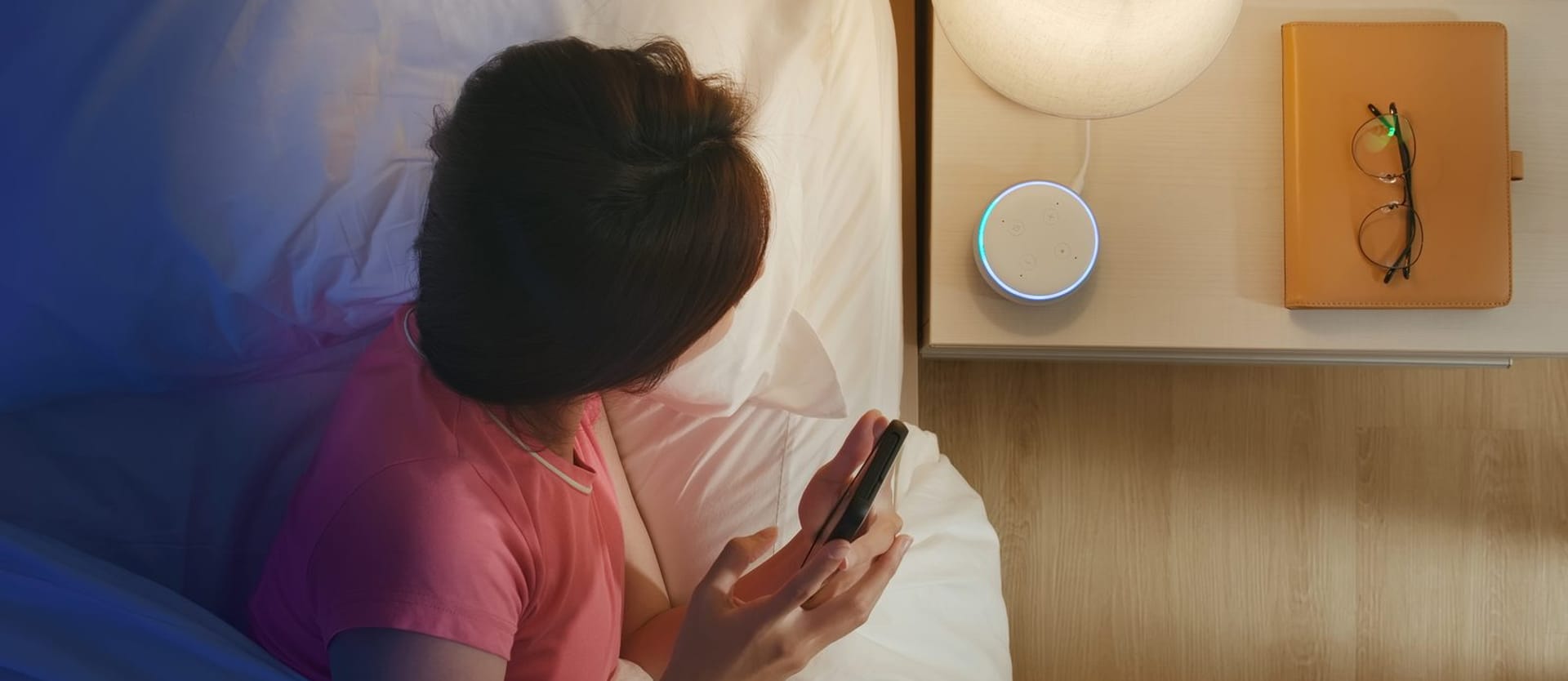Every now and then, a big hotel brand introduces its own take on the “hotel room of the future”. IHG, Marriott, Accor, and many more have been developing automatic, contactless, personalized experiences to wow their guests and redefine the hospitality market. Marriott even launched a whole 10,000-square foot lab with model rooms where the brand can design and test innovative technologies.
But big ideas don’t have to come from big brands. The Internet of Things (IoT) and machine learning that are powering smart hotel applications are accessible to everyone bold enough to try. Here, we will explain what comprises the smart hotel and how you can join the future by establishing an IoT architecture.
What is a smart hotel? IoT hospitality applications
A smart hotel is an umbrella term for Internet of Things (IoT) devices used to streamline operations and provide a better guest experience in hospitality. IoT is used in tons of different industries for automation and connectivity. Valuable human resources can be redirected to more creative tasks and the data that IoT sensors acquire is an invaluable source of information about customers and operational efficiency.
Previously, we talked about the smart hotel trends shaping the future hospitality experience. But here, we want to focus on a variety of smart hotel technologies a property can already use. Here are a few notable applications.
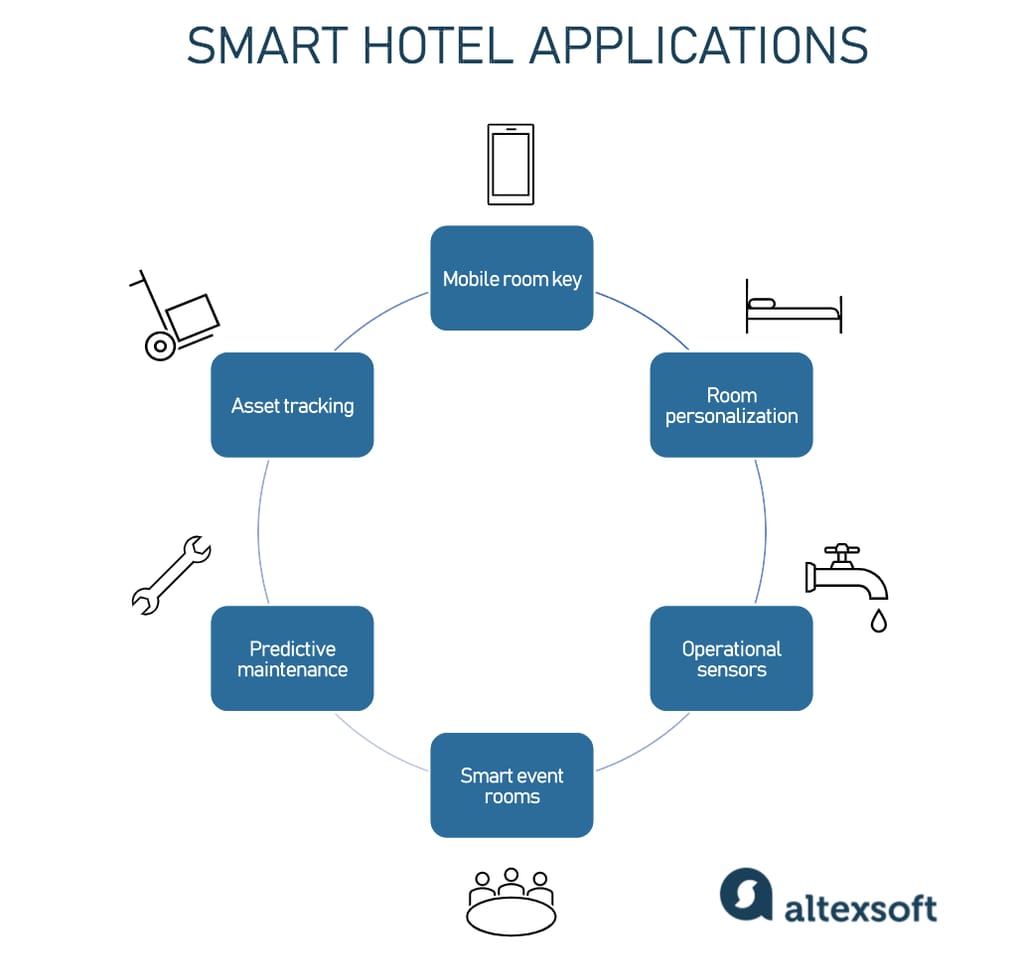
IoT in hospitality use cases
Mobile keys
A mobile (digital) key technology has many benefits over RFID keycards. Not only does it eliminate plastic waste that comes with producing cards, but it also provide more security. Since guests’ phones are typically locked with a password, fingertip, or Face ID, the mobile key is protected even if the device is stolen. At the same time, it’s more difficult to lose the phone than the keycard, removing the need to reissue it.
There are two ways to implement a mobile key.
Bluetooth. This method involves integrating a mobile key provider with a property management system (PMS) or vacation rental software and installing a Bluetooth module on the locks. When the room is booked, a hotel issues a unique access key and sends it to the guest via email. A guest downloads a hotel’s or a provider’s app and enters the access code to log in. When they arrive, they simply need to hover the phone over the room lock and it will open in a few seconds.
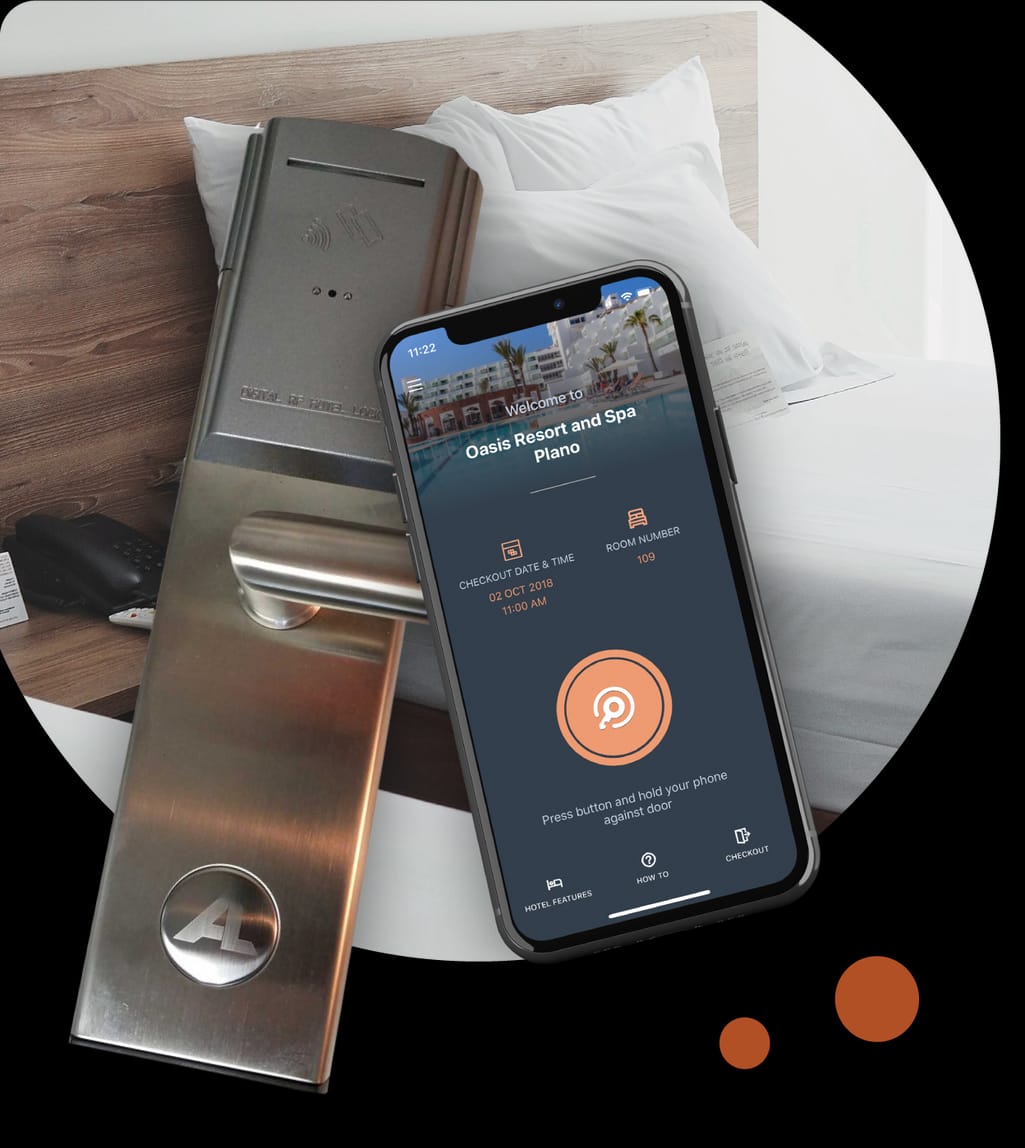
A smart lock and a Bluetooth-enabled key Source: OpenKey
IoT. A more modern and faster way to unlock doors is using a phone’s internet connection (Wi-Fi or 3G/4G/5G). For this, old locks need to be upgraded with IoT sensors but compared to Bluetooth locks, a user doesn’t need to download any apps. Guests receive a booking confirmation along with a link to the web app, which opens in a mobile browser. Then, they can open the door from anywhere in the world by tapping the button. On its side, a hotel can see in real-time when the lock activates, showing when the guests checked in or when housekeeping completed their tasks. From your PMS, you can also configure time-based access, so that keys work for certain keyholders at certain times.

WiFi room unlocking Source: 4Suites
One disadvantage of using mobile keys is that phones can die. If this happens, you will have to provide a guest with a traditional keycard.
Room personalization
Hospitality is about giving shelter and comfort. But comfort is not universal. Using a network of connected devices, a customer can control their stay to the smallest detail from their phone or a device provided with the room, like Amazon Alexa or Google Nest. The possible customizations include the following.
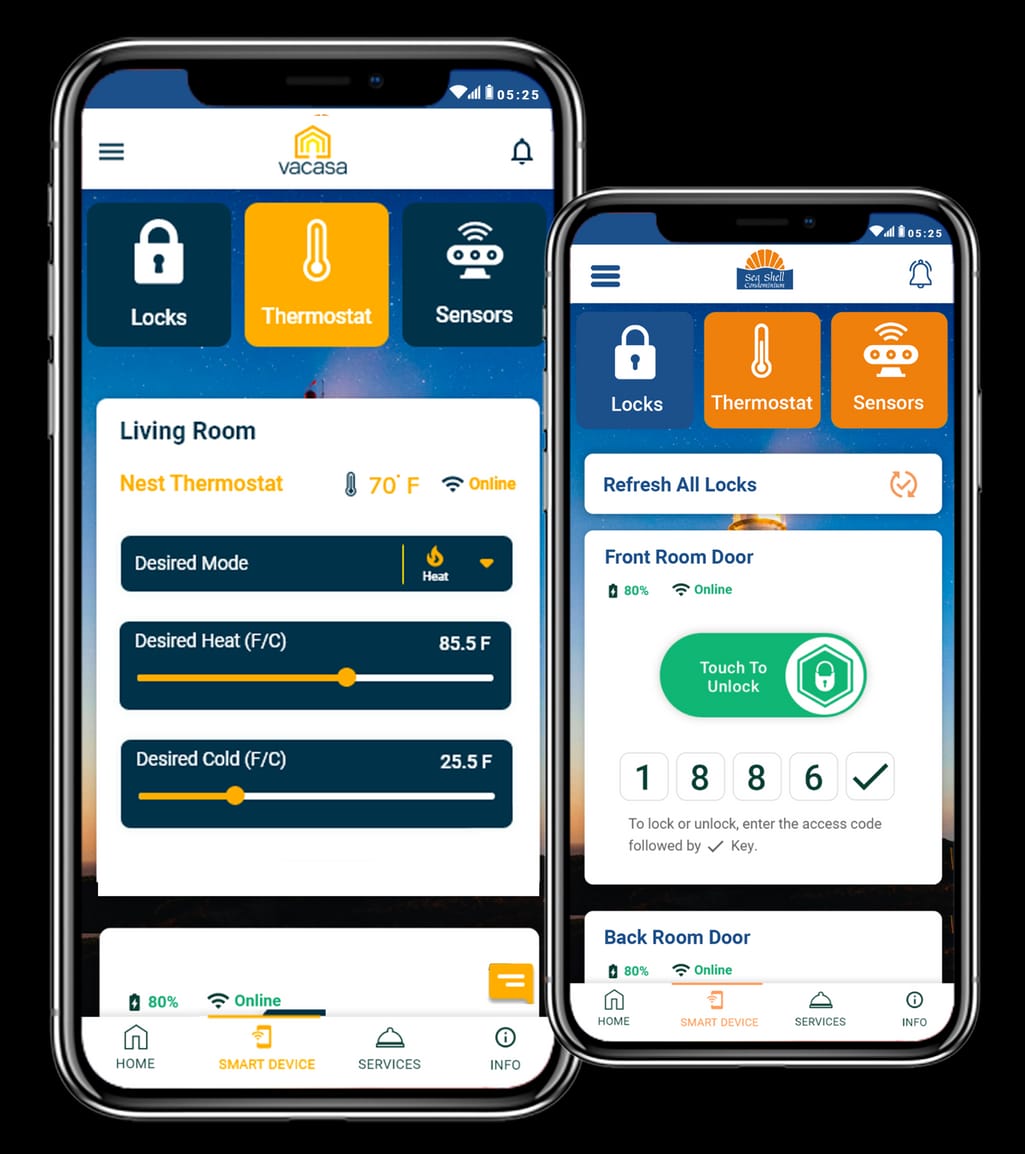
An app allowing guests to access different room features from a single interface Source: Lynx
Lighting. Guests can control the color, temperature, and brightness of individual and groups of lights in the room, schedule their activities, and change the overall mood of the room as they desire.
Room temperature. Heating or cooling the rooms before arrival, scheduling the temperature to go down during the night, and automatically resetting the thermostat after guests check out are some of the ways smart room temperature configuration can benefit guests and the hotel’s energy savings.
Curtains and shades. Guests can open and close curtains remotely or set up automatic controls based on time, for example, at sunrise and sunset.
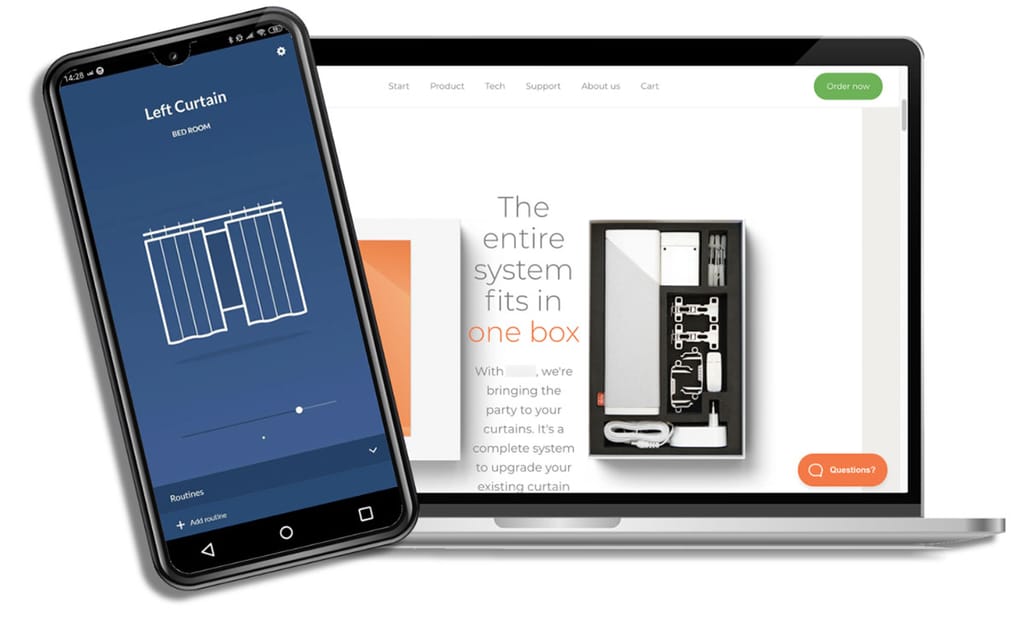 Example of curtains control with a phone Source: Expanice
Example of curtains control with a phone Source: Expanice
Operational control
A variety of sensors can alert you about what’s happening at your property at any given moment. This includes the following.
Air quality. Tracking CO2 levels can help ensure that the space is well-ventilated and the risk of airborne virus transmission is minimal.
Humidity. Humid spaces feel uncomfortable and cause damage to your building and interior. If your hotel doesn’t dehumidify properly, it might be a sign that your AC units are too weak or the room doesn’t have enough time to remove humidity in the air between guests.
Water leakage. Hotels are huge, complex systems with many possibilities to experience a leak: pipes, taps, refrigeration, water heaters, restrooms, and many more areas are vulnerable to water leakage. Luckily, water leakage sensors can give you peace of mind and prevent any serious damage from happening.
Occupancy. Hotels can’t usually control the energy each room is consuming. But they can minimize costs by tracking what rooms are not currently occupied. For example, you can automatically turn the thermostat off or lower the temperature when the room’s empty. At the same time, the sensor will detect the person and let your housekeeping staff know that they should return later without disturbing the guest.
Smart event rooms
Hotel conference and event spaces can also be more easily customized with the use of IoT. From a single platform, event hosts can operate and schedule light settings, temperature, door accesses, and more.
 Monitoring meeting room spaces Source: HC Technologies
Monitoring meeting room spaces Source: HC Technologies
Predictive maintenance
Typically, hotels employ reactive (fixing or replacing equipment after the guests complain) or preventive (doing scheduled inspections) maintenance. Predictive maintenance, on the other hand, uses sensors and machine learning that give the probability of failure and tell us how soon the equipment is likely to break down. This means that you won’t have to spend time and money on ineffective inspections and will get timely alerts before guests complain about an inoperable elevator or lack of hot water. This way, repairs happen in a timely manner without downtime.
Asset tracking
A hotel is a machine that never stops and it’s difficult to always be on top of things with inventory, equipment, and staff. IoT provides lots of opportunities for operational efficiency, including
- smart shelves with sensors alerting when the stock needs to be replenished,
- RFID and GPS tags to locate and identify lost equipment,
- asset usage tracking to control and analyze how soon the inventory depletes and compare the cost of ownership of different equipment,
- asset reservation, assigning, and permission setting.
Finally, let’s learn what an IoT network entails and how to set up one.
Smart hotel components: How does it work?
The Internet of Things is not a single technology, but a combination of many of them working in tandem. The architecture of an IoT system may vary in complexity and the type of solution you’re building.
But it typically consists of the following building blocks.
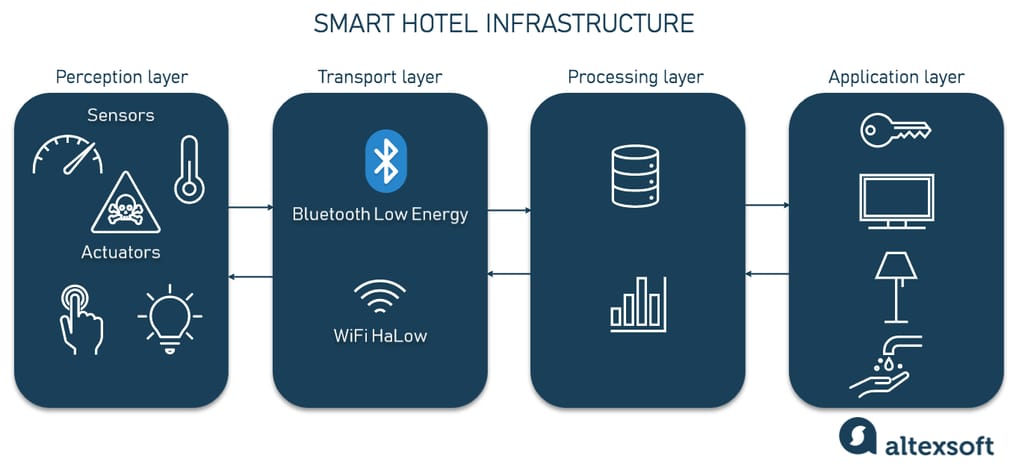 Smart hotel components
Smart hotel components
- perception layer (smart sensors and actuators) - physical devices that convert analog information into digital data,
- transport layer (networks and gateways) that transfer data from the physical layer to the cloud,
- processing layer (middleware or IoT platforms), where this data is stored and prepared for usage, and
- application layer (apps, analytics), where data is put into business usage.
Let’s review each of these layers separately.
Perception layer: sensors and actuators
A sensor is a small device that monitors a certain condition and alerts about any changes. Thermometers and water leak sensors, for example, take physical characteristics and transform them into electrical signals. Data from sensors is stored and processed for useful insights and analytics.
An actuator is the opposite. It takes an electrical signal from the system and converts it into a physical event. For example, a smart lightbulb will use input from an app to change its color or an electric lock will unlock the door.
Sensors and actuators are typically connected. If a thermometer senses heat beyond the required level, the AC will be activated to lower the temperature.
But often, actuators are activated not by a sensor noticing a change in environment, but by a user physically changing parameters via a control device, such as a phone or a special interface.
At the same time, sensors are not always placed to alert about certain conditions. Sometimes, they simply gather data for intelligence. A motion sensor can be connected to an actuator that turns on the light but can also just collect statistics on how much traffic a certain room has.
Transport layer: BLE vs WiFi
Perception layer devices are connected to the Internet using different communication hardware, networks, and services. The most common communication methods for wireless communication in hospitality are Bluetooth Low Energy and WiFi.
Bluetooth Low Energy (BLE) was designed specifically to consume less energy so devices can run for a very long time on a small battery. This means that the batteries in all your door locks wouldn’t need to be changed for a very long time. At the same time, BLE can only transmit lightweight data, such as numerical data from sensors. The range can differ depending on how many obstacles between components there are. It’s also pretty slow with a bandwidth of around 1 Mbps, so it will take a few seconds to connect.
The most advanced technology for IoT communication is WiFi. It’s much faster (up to 1.3 Gbps), making it suitable for transferring photos or videos. A standard called WiFi HaLow was specifically created for IoT applications. It consumes just as little energy as Bluetooth does and reaches longer distances. It’s not, however, extensively used, so pay attention to this fact when choosing your IoT provider. Otherwise, you can expect your devices to use 10 times more energy than Bluetooth-powered ones.
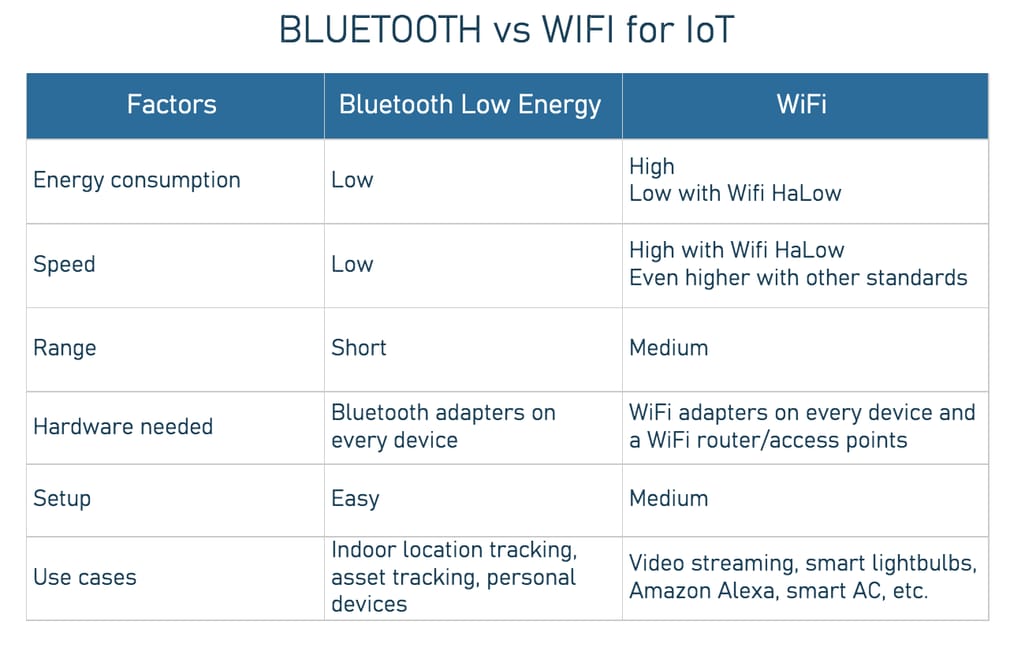 Comparing Bluetooth Low Energy and WiFi for IoT scenarios
Comparing Bluetooth Low Energy and WiFi for IoT scenarios
All in all, it makes sense to use both technologies for different applications and consider energy and setup costs in the equation.
Processing layer: middleware and IoT platforms
Data captured by devices is transmitted via communication methods to cloud middleware - IoT platforms responsible for linking that data to applications and other systems. IoT middleware providers like AWS, Cisco, Google Cloud, IBM Watson, and Microsoft Azure allow you to configure each piece of the IoT network, collect, process, and store data, then analyze and even visualize it.

AWS IoT infrastructure Source: AWS
If you’re employing the services of a hospitality IoT developer, they will take care of the processing part, providing you with an interface to easily manage the network in your PMS. But if you’re building your own network, consider the services of a tech partner, who will advise you and help with development.
Application layer: interfaces
IoT middleware feeds the processed data onto the application layer, where end-users can operate various software to review analytics and access IoT features.
Applications can be accessed by two parties: guests and hotel staff.
For guests, there is a variety of apps to control smart features:
- branded hotel apps or provider apps,
- web apps,
- tablets installed in rooms,
- kiosks,
- voice-activated interfaces.
Hotel employees typically can interact with these applications via a property management system.
In the next section, we will talk about how to approach IoT development.
Hospitality IoT development: Build vs Buy
The Internet of Things network is an ambitious venture. Depending on your goals and resources, you can consider two approaches to IoT adoption. Before you consider any of the choices, answer these questions:
- What specific applications do you want to adopt?
- How do you want your guests to access those applications?
- How do you want your staff to monitor those applications?
- What technical resources do you have to adopt IoT?
Let’s review how different methods can answer those questions.
When to buy?
There’s no unified hotel IoT that you can set up to transform your property into a connectivity marvel. The market consists of smaller players, each providing one or two specialized solutions. So, in most cases, you’d have to link to separate systems and build a seamless connection between them.
It’s different if you’re planning to integrate just one technology — for example, only smart room controls or only mobile keys. In this case, you can benefit a lot from an out-of-the-box solution. A vendor will decide what type of devices and how many of them you will need, set them all up, and help you integrate your PMS with their interface.
But if you plan to grow your network using different vendors, you’ll be facing technical difficulties. Interfaces will have to be integrated one with another, otherwise, your staff will have to operate between a few different systems all the time. This and other issues lead businesses to the option of building a custom IoT infrastructure.
When to build?
Building something on your own or with a tech partner is not an easy feat, but it’s very rewarding.
First of all, you’re not limited to vendors and you get to choose everything on your own, from hardware to communication channels.
You can also ensure that the end result matches your original business requirements and from that foundation, you can comfortably grow according to your strategy.
Also, consider whether you want to use your in-house tech team or outsource tech resources to experts who might be in a better position to advise you on the most effective technologies and methods.

Maryna is a passionate writer with a talent for simplifying complex topics for readers of all backgrounds. With 7 years of experience writing about travel technology, she is well-versed in the field. Outside of her professional writing, she enjoys reading, video games, and fashion.
Want to write an article for our blog? Read our requirements and guidelines to become a contributor.
